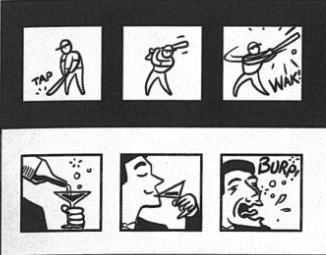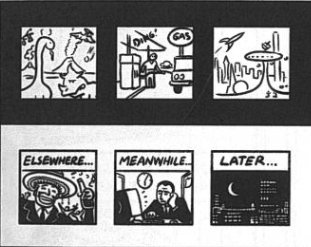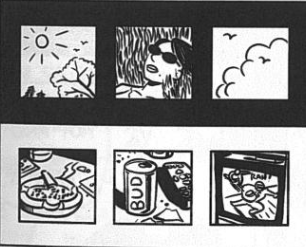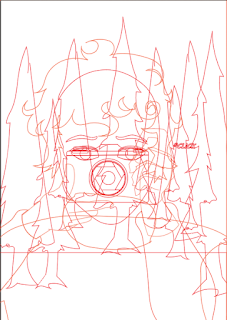Illustration and Visual Narrative | Task 3
Week 10 - Week 11 (27/11/2023 - 8/12/2023)
Melvin Yung Khun Yew | 0357241 | Bachelor of Design (Hons) in Creative
Media
COM 61304 Illustration and Visual
Narrative
Task 3
This portfolio consists of:
Click on the link to jump to that part of the portfolio
Lectures
↑↑↑ Back to top ↑↑↑
Week 10
Recap - 3 Acts Structure
-
Setup
The world in which the protagonist exists before the journey. The setup usually ends with the conflict being revealed.
-
Rising action
The series of obstacles the protagonist must overcome. Each obstacle is usually more difficult and with higher stakes than the previous one.
-
Conflict
The point of highest tension, and the major decisive turning point for the protagonist.
Resolution: The conflict’s conclusion. This is where the protagonist finally overcomes the conflict, learns to accept it, or is ultimately defeated by it. Regardless, this is where the journey ends.
Transitions - Scott McCloud's analysis and theory
Moment to moment
Action to action
Subject to subject
Scene to scene
Aspect to aspect
Non sequitur
Important aspects when creating a story
- Continuity
- Participation of the reader
- Transitions
- Point of view
Instructions
↑↑↑ Back to top ↑↑↑
Though this third assignment is not mentioned in the module information,
Mr Hafiz gave the class a quick brief on this third assignment that
spans a week and learning outcomes through the online Microsoft Teams
meeting and on Google Classroom.
Task 3 (20%) - Individual: Digital Triptych
For the third task, I'm instructed to do a digital triptych comprising three panels, the moment before, the climactic turning point, and the moment after while applying Scott McCloud's theory on transitions.
For the third task, I'm instructed to do a digital triptych comprising three panels, the moment before, the climactic turning point, and the moment after while applying Scott McCloud's theory on transitions.
Submission
- Digital triptych with three panels
Learning goals
- Understanding and application of 3 act structure in storytelling
- Understanding and application of Scott McCloud's transition theory on the comics
Work Process
↑↑↑ Back to top ↑↑↑
Ideation
Based on the urban legend, I came up with an idea that is to show a
man with a camera and how his actions initiate the urban legend
beginning with the witness testimony backed up by the photos as
evidence.
Thus this third task requires me to illustrate what happened before and
after the man witnessed the mysterious figure in the woods (climax)
which eventually turned this encounter into an urban legend that spread
among the community.
To ease into the scene that happen before the climactic event of the
storyline starts off with a man with a camera in his hands becomes
alerted and suspicious of a "creak" sound symbolizing the twigs breaking
sound in the woods. I believe that we have common sense that inside the
wild forest isn't supposed to have creaking sounds all the time, thus
this uncommon event surely can get anyone even a grown man in caution.
After the man witnesses the mysterious creature in the woods (climactic
turning point), surely there's reaction for him to record and document
his encounter using his trusty camera with curiosity in his heart. And
that's how people claimed to have sightings of Bigfoot with images on
the Internet.
Going with this story flow, I decided to select the
subject-to-subject transition type as it is most suitable to
describe the transitions happening between the panels.
Sketches
During the sketching period, I tried different camera angles and
perspectives to portray the mood and atmosphere of the scene.

|
| The first version sketch of moments before the climax panel |
Digitalization
Maintaining the graphic consistency between the panels, I followed and
used the same colour theme and the same art styles as the climax of the
story.
The panel for the moment after the climax
↑↑↑ Back to top ↑↑↑
Final Work
With an animated GIF climax scene
Feedback
↑↑↑ Back to top ↑↑↑
Week 11
General feedback
Proceed and understand the transition type between the sketches first
before digitalising the sketch in Adobe Illustrator.
Reflection
↑↑↑ Back to top ↑↑↑
-
Experiences
Even though this task is rather quick and short given that we have one week to complete the task, the amount of knowledge and theories compressed into the period of this one week is surely on another level that I need to account for starting this very moment when I'm to storytelling by creating illustrations. I believe that the theories for creating a fine story flow I've learned during these 2 weeks are vital for my work and for my future career.
-
Observation
Reviewing the materials provided by Mr Hafiz, multiple examples given to explain each of the transition types by Scott McCloud gave me a better understanding of the theories to create a cohesive story flow.
-
Findings
I found a lot of cool info that piqued my interest in how to create a successful digital triptych and be mindful of the transitions that can contribute to the better storytelling of an illustration through visual graphics only.

















Comments
Post a Comment